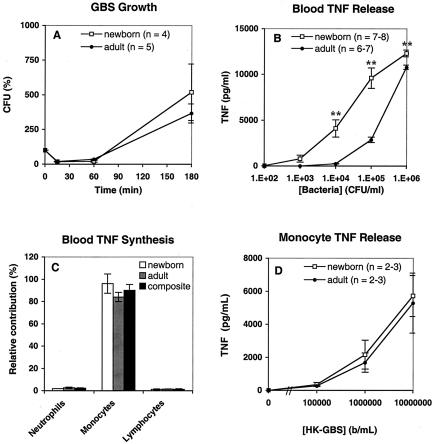FIG. 1.
GBS induces TNF-α release from monocytes in newborn and adult blood. (A) Growth of GBS type III COH-1 added at 104 bacteria/ml to citrated adult blood (closed symbols) or newborn cord blood (open symbols) and incubated at 37°C. Bacterial growth was assessed by quantitative culture at the time indicated. (B) Extracellular medium was collected at 5 h, and TNF-α was measured by ELISA. TNF-α release is plotted relative to input inoculum (102 to 106 bacteria/ml). The total number of subjects studied (n) is indicated in each graph. Data points represent means ± standard errors of the means. P values were calculated for the comparison of TNF-α release in newborn and adult blood (**, P < 0.01). (C) Analysis of TNF-α-positive leukocytes derived from newborn blood (n = 2) and adult blood (n = 2) revealed that monocytes accounted for the greatest proportion of TNF-α synthesis. Differences between the relative contributions of composite monocytes and composite neutrophils or lymphocytes were significant (P < 0.001). (D) HK-GBS was added to neonatal or adult monocytes suspended to 105 bacteria/ml in 10% autologous serum. After a 5-h incubation at 37°C, the supernatants were collected for TNF-α measurement.

